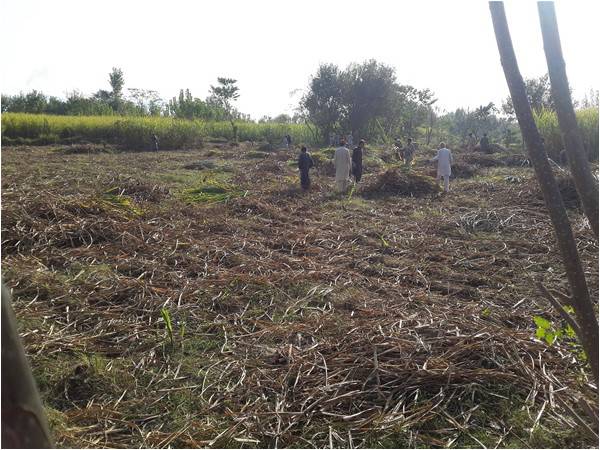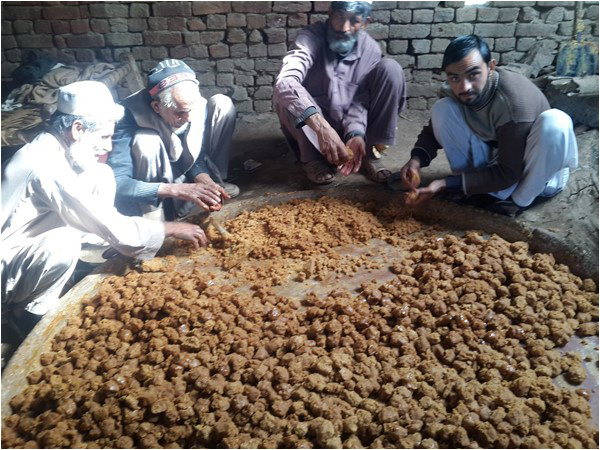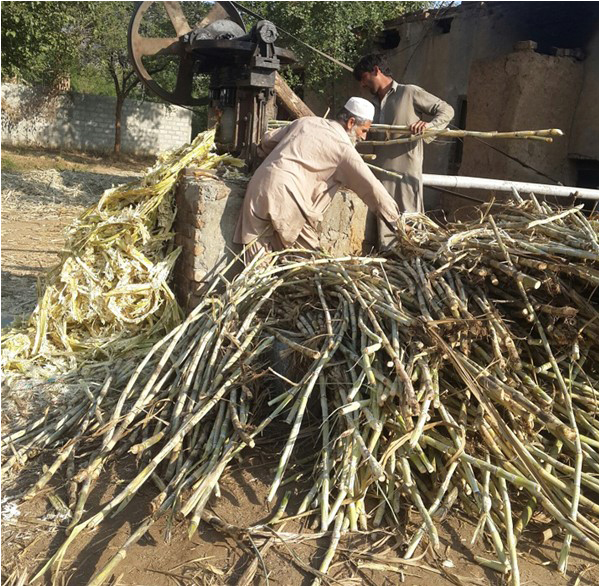
Traditionally, the Hujra is considered a centre of social life in Pashtun society. However, it has been losing its lustre and utility over the years. In the sugarcane-producing districts of Khyber Pakhtukhwa, the arrival of autumn is not only marked by shedding of leaves by the trees but also by the peasants throwing away the dullness and boredom induced by the scorching heat of summer. The beginning of the proverbial gloomy winter heralds a phase of festivity and prosperity for the poor growers. The Gur-making units are kick-started and a fresh wave of social and economic activities is set into motion. In winter, it is the Gharrain – the Gur-making unit – that provides the much needed warmth, company and cash for a full life.
Sugarcane growing is a laborious year-long exercise. However, like any other cash crop, its harvest infuses a sense of profound jubilation and celebration in the whole rural community. The poor growers live from hand to mouth but when the produce gets ready, their magnanimity and generosity reach a crescendo. Everyone is welcome into the Gharrain not only for sampling the Gur but for the plentiful meals available at breakfast, lunch and dinner. My mother, in such a context, is well-acquainted with how tiresome it is to feed dozens of people three times a day!

The Gur-making process is inherently social because it requires a significant workforce. If all the required labour is hired on a payment basis, then the exercise will be no more profitable. For the process to remain economically viable, greater social cohesion and interdependence is needed. A single family with the help of a few paid labourers cannot run the unit efficiently. The harvester is dependent on the support of his fellow villagers to turn the ripe harvest into the finished product of Gur.
The process begins with cutting and peeling off the sugarcane in the fields. This cleansing of sugarcanes from straw and bringing them to the unit is a tedious process in itself. However, the cattle-growers undertake this exercise to get fodder for their cattle. The villagers assemble in the mill early in the morning and then move to the fields along with the women. The sugarcane cutting is carried out according to the daily requirements of the mill. Excessive cutting is avoided because dumping of sugarcanes in the mill may cause serious problems in case of bad weather (rain).
The cutting process is called ‘Wutt’ in the local dialect. The men and women work together in the fields with a lot of gossip going around. This tedious process is made bearable by the charm of working together for both genders. Usually, the women assist the men in the fields but this activity is conspicuously female dominated. The women, too, relish this exercise because it provides them an opportunity for venturing out of the confines of the home. In the rural context, no other activity can match the space it provides for cross-gender socialising.
The villagers eagerly undertake this cutting exercise because they get enough fodder for their cattle. There is no pause in this fodder-gathering exercise because the excess fodder is stored for consumption in the lean period. The livestock flourishes in the autumn because of this abundance of food available to them around the clock. The highlanders descend from the northern mountains to the plains in autumn to avoid the wrath of the cold weather spell in the mountains and to benefit from the availability of plentiful fodder for the cattle. They also work as paid labour to earn a decent livelihood. How easily these highlanders assimilate in the local community tells a lot about the hospitality and magnanimity still prevalent in the rural areas. In short, the celebratory mode of life is shared by all and sundry.

Once the sugar crop is brought to the unit, the first step in the cycle of Gur-making is crushing of the sugarcanes. Earlier, this crushing process was driven by a pair of oxen. Then in the early 1990s, it was replaced by a machine. Now this mechanised crushing takes half an hour to distill juice for one complete cycle (called ‘puur’ in the local dialect) of Gur making. This juice is then heated for almost three long hours in a pan called ‘Karheay’ to evaporate the excess water. The green straws of sugarcane go to the cattle and the dry straw is mixed up with the dried bagasse (left over from the crushing process) to make fuel for this heating process.
The children, after returning from school, rush to the unit and play there till late evening. This mixture of straw and bagasse provides them a soft mat for wrestling and jumping. They play to their heart’s content and enjoy freshly made hot Gur. They eat sugarcane stalks in plenty to replenish their energy for yet more mirth and merrymaking. In the evening, the villagers visit the unit again to enjoy freshly prepared hot Gur and provide some support in the process.
There is always a need for helping hands to run the unit smoothly. This cooperation is based on reciprocity.
Once the juice is heated up to the desired level, it is moved to another earthen bowl for making Gur pieces. This process is time-bound. Undue delay in this process can spoil the product because the coarse pieces of Gur can be only made when the product is still hot. For this packaging process to e completed in an hour’s time, seven to eight people are needed to be present under the shabby roof of the unit. They gather around the bowl called ‘Attara’ in local dialect and prepare the Gur pieces. They gossip about various social and political issues in detail. The discussion is quite interesting but only those can enjoy it who know the art of making Gur pieces from the heated distillate.
Some mills work only from dawn to dusk and others run for 24 hours a day. The latter type needs the presence of people at night too. This is the most charming aspect of the village’s social life. Amateurs use to visit the Gaarain at night regularly and enjoy the hot Gur in the chilling cold with plenty of people present to gossip and socialise. This night life may be not as glamourous and colourful as that in big cities but it is what the poor villagers try to console themselves with.
In many cases, Gur-making is the only activity that has still kept the social fabric of rural life intact. With the recent improvements in the economic wellbeing of the people, consumers of Gur are rapidly decreasing but the sugarcane growers are not ready to let the ‘sugar mafias’ exploit them. This Gur-making provides the growers leverage against the middlemen and sugar mill owners. They are not dependent on the middlemen for the sale of sugarcane and on the government for support prices. It is a strange mix of independence and interdependence at the same time.
There is hardly sufficient space available for storing the Gur in large quantities; therefore the farmers transport it to the nearby Gur mandi at the earliest. It ensures a smooth flow of cash along with an opportunity for the hardworking harvester to relish the taste of chappli kabab regularly. There is a special category of Gur termed as ‘Masalehdar gur’ to be presented to close friends and relatives as a gift. It is prepared by mixing nuts with the semi-molten Gur. To get this special gift of Gur every winter, you would need to have some generous friends from a rural background – otherwise you might just have to do make do with the mere idea of ‘Masalehdar gur’.
Sugarcane growing is a laborious year-long exercise. However, like any other cash crop, its harvest infuses a sense of profound jubilation and celebration in the whole rural community. The poor growers live from hand to mouth but when the produce gets ready, their magnanimity and generosity reach a crescendo. Everyone is welcome into the Gharrain not only for sampling the Gur but for the plentiful meals available at breakfast, lunch and dinner. My mother, in such a context, is well-acquainted with how tiresome it is to feed dozens of people three times a day!

The Gur-making process is inherently social because it requires a significant workforce. If all the required labour is hired on a payment basis, then the exercise will be no more profitable. For the process to remain economically viable, greater social cohesion and interdependence is needed. A single family with the help of a few paid labourers cannot run the unit efficiently. The harvester is dependent on the support of his fellow villagers to turn the ripe harvest into the finished product of Gur.
The process begins with cutting and peeling off the sugarcane in the fields. This cleansing of sugarcanes from straw and bringing them to the unit is a tedious process in itself. However, the cattle-growers undertake this exercise to get fodder for their cattle. The villagers assemble in the mill early in the morning and then move to the fields along with the women. The sugarcane cutting is carried out according to the daily requirements of the mill. Excessive cutting is avoided because dumping of sugarcanes in the mill may cause serious problems in case of bad weather (rain).
In the rural context, no other activity can match the space it provides for cross-gender socialising
The cutting process is called ‘Wutt’ in the local dialect. The men and women work together in the fields with a lot of gossip going around. This tedious process is made bearable by the charm of working together for both genders. Usually, the women assist the men in the fields but this activity is conspicuously female dominated. The women, too, relish this exercise because it provides them an opportunity for venturing out of the confines of the home. In the rural context, no other activity can match the space it provides for cross-gender socialising.
The villagers eagerly undertake this cutting exercise because they get enough fodder for their cattle. There is no pause in this fodder-gathering exercise because the excess fodder is stored for consumption in the lean period. The livestock flourishes in the autumn because of this abundance of food available to them around the clock. The highlanders descend from the northern mountains to the plains in autumn to avoid the wrath of the cold weather spell in the mountains and to benefit from the availability of plentiful fodder for the cattle. They also work as paid labour to earn a decent livelihood. How easily these highlanders assimilate in the local community tells a lot about the hospitality and magnanimity still prevalent in the rural areas. In short, the celebratory mode of life is shared by all and sundry.

Once the sugar crop is brought to the unit, the first step in the cycle of Gur-making is crushing of the sugarcanes. Earlier, this crushing process was driven by a pair of oxen. Then in the early 1990s, it was replaced by a machine. Now this mechanised crushing takes half an hour to distill juice for one complete cycle (called ‘puur’ in the local dialect) of Gur making. This juice is then heated for almost three long hours in a pan called ‘Karheay’ to evaporate the excess water. The green straws of sugarcane go to the cattle and the dry straw is mixed up with the dried bagasse (left over from the crushing process) to make fuel for this heating process.
The children, after returning from school, rush to the unit and play there till late evening. This mixture of straw and bagasse provides them a soft mat for wrestling and jumping. They play to their heart’s content and enjoy freshly made hot Gur. They eat sugarcane stalks in plenty to replenish their energy for yet more mirth and merrymaking. In the evening, the villagers visit the unit again to enjoy freshly prepared hot Gur and provide some support in the process.
There is always a need for helping hands to run the unit smoothly. This cooperation is based on reciprocity.
Once the juice is heated up to the desired level, it is moved to another earthen bowl for making Gur pieces. This process is time-bound. Undue delay in this process can spoil the product because the coarse pieces of Gur can be only made when the product is still hot. For this packaging process to e completed in an hour’s time, seven to eight people are needed to be present under the shabby roof of the unit. They gather around the bowl called ‘Attara’ in local dialect and prepare the Gur pieces. They gossip about various social and political issues in detail. The discussion is quite interesting but only those can enjoy it who know the art of making Gur pieces from the heated distillate.
Some mills work only from dawn to dusk and others run for 24 hours a day. The latter type needs the presence of people at night too. This is the most charming aspect of the village’s social life. Amateurs use to visit the Gaarain at night regularly and enjoy the hot Gur in the chilling cold with plenty of people present to gossip and socialise. This night life may be not as glamourous and colourful as that in big cities but it is what the poor villagers try to console themselves with.
In many cases, Gur-making is the only activity that has still kept the social fabric of rural life intact. With the recent improvements in the economic wellbeing of the people, consumers of Gur are rapidly decreasing but the sugarcane growers are not ready to let the ‘sugar mafias’ exploit them. This Gur-making provides the growers leverage against the middlemen and sugar mill owners. They are not dependent on the middlemen for the sale of sugarcane and on the government for support prices. It is a strange mix of independence and interdependence at the same time.
There is hardly sufficient space available for storing the Gur in large quantities; therefore the farmers transport it to the nearby Gur mandi at the earliest. It ensures a smooth flow of cash along with an opportunity for the hardworking harvester to relish the taste of chappli kabab regularly. There is a special category of Gur termed as ‘Masalehdar gur’ to be presented to close friends and relatives as a gift. It is prepared by mixing nuts with the semi-molten Gur. To get this special gift of Gur every winter, you would need to have some generous friends from a rural background – otherwise you might just have to do make do with the mere idea of ‘Masalehdar gur’.

